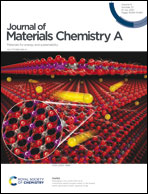Tuning of Pt–Co nanoparticle motifs for enhancing the HOR performance in alkaline media†
Abstract
For a future sustainable hydrogen economy, the electrocatalysis of hydrogen oxidation/evolution reactions (HOR/HER) needs to be better understood. In order to describe the strong alteration of HOR/HER rates on platinum group metals (PGM) in acidic and alkaline media, at least two prominent descriptors based on a Pt–Had binding energy model and a bifunctional model are frequently discussed in the literature. A clear discrimination of these both descriptors for PGM-based multi-metallic materials, yet, remains a critical challenge. To solve this dilemma, we have made use of the oxophilic and structural properties of cobalt atoms in Pt-based nano-materials to tune their catalytic HOR performance in alkaline media. More precisely, we have designed PtxCo1−x nanoparticles with various structural motifs. Remarkably, the surface rearrangement of PtxCo1−x nanoparticles along the uniform alloy, Pt-rich shell, and Co-segregated core–shell motifs is controlled by the electrochemical environment. To identify the elemental distribution of Co and Pt atoms, a new descriptor is presented in this work, the so-called Q(Hupd)/Q(Coz+) ratio. The coverage of OHad species can be controlled by the coverage of oxophilic Co surface atoms to investigate the bifunctional mechanism on the HOR kinetics in alkaline media. Thus, we are able to correlate the HOR exchange current densities with tuneable Co coverage on the particle surface to mimic e.g. the coverage of “Co(hydr)oxide clusters”. On the other hand, the strain effect to modify the Pt–Had binding energy is solely investigated on a Pt-rich shell induced by a Co-rich particle core. Despite the separation of these critical model parameters, cobalt as an oxophilic component strongly bonds OHad species at the bimetallic particle surface and modifies the HOR kinetics. In contrast, the induced lattice strain in the Pt-enriched shell of dealloyed core–shell nanoparticles leads to an increase of the Pt surface area-based specific exchange current density j0spec by a factor of ∼2 compared to pure Pt. Based on our results, we provide deeper insights into the kinetics and mechanism of the HOR on PtxCo1−x catalysts with different structural nanoparticle motifs in an alkaline environment.



 Please wait while we load your content...
Please wait while we load your content...